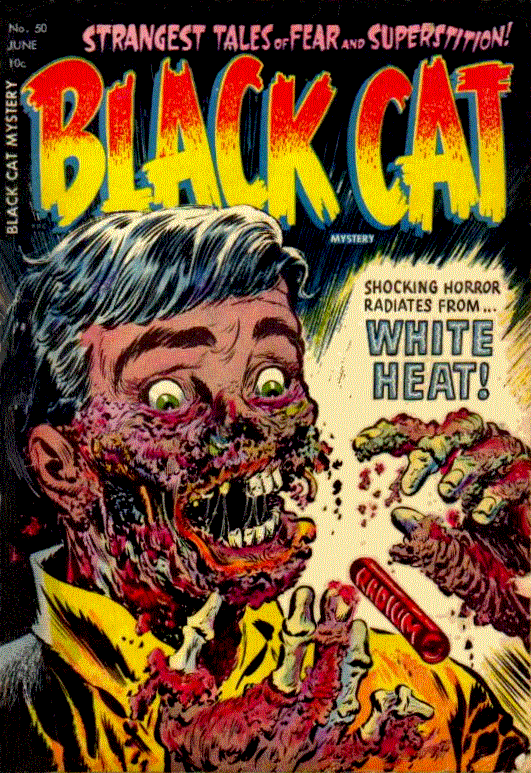

Black Cat Mystery (1946 Series), Number 50, June, 1954, cover.
©Harvey Publications (Home Comics)
"White Heat"
Cover credits:
Editor: ?
Penciller: Lee Elias
Inker: Lee Elias
Letterer: ?
Colorist: ?
White Heat story credits:
Writer: ?
Penciller: Joe Certa
Inker: ?
Letterer: ?
Colorist: ?
The cover of Black Cat Mystery 50 graphically dramatizes a man's face being burned away by radiation poisoning. This issue is avidly sought by collectors, selling for hundreds of dollars in prime condition. The history of Black Cat provides a quick overview of comic book trends in the late 1940s and early 1950s. Starting in June-July 1946, Black Cat Comicsfeatured the adventures of Black Cat, "Hollywood's Glamorous Detective Star." A costumed superheroine, she sported a fast motorcycle, mask, boots, gloves and a skimpy bathing suit. The first issue had artwork by Joe Kubert and Joe Simon. Issues 16-19 reflected a growing interest in the Western genre with a temporary title change to Black Cat Western, with Black Cat often riding a horse rather than a motorcycle on the covers of issues 12 to 20. In issue 28, Black Cat acquired a sidekick named Kit. Later cover artwork tended toward "good girl" art and bondage themes. With issue 30, the comic book fell victim to the waning interest in superheroes by undergoing a title and theme change to Black Cat Mystery, with Black Cat herself making a cover appearance only. Issues 31 to 53 had classic, lurid horror covers with plenty of bondage, monsters, and gore. Issue 33 was used as an example of an unsavory comic book in Parade of Pleasure, and issues 36 and 39 got the same treatment in Seduction of the Innocents. Issue 50 is drawn from the horror era. As the noose tightened on the comic-book industry's neck, the book became a moving target, with title changes to Black Cat Western Mystery (54), Black Cat Western, again featuring the superheroine on horseback (55 and 56), Black Cat Mystery (57), Black Cat Mystic (58 to 62) and finally back to Black Cat with the superheroine showing off her judo tricks (giant issues 63 to 65), ceasing publication in April 1963.
Would the unfortunate gentleman on the cover have really gotten his face burned off by his piece of radium? Let's assume that he is holding a cylinder of pure radium-226 about 10 cm long and 1 cm radius. It would weigh about 173 g, nearly twice the annual worldwide production of all radium compounds! Radium occurs geologically in association with uranium at about 1 milligram of radium per 3 kilograms of uranium, requiring about 10 metric tons of ore to produce 1 milligram of radium. Radium-226 decays to radon-222 by alpha particle emission with a half-life of 1600 years. Our cylinder of radium would directly produce about 171 Curies of alpha radiation, or about 4.8 Watts of power plus up to four times that power from secondary decay of the daughter isotopes. The cylinder would merely feel warm or hot to the touch; most of the alpha radiation could be stopped by a piece of paper. In addition, radium-226 decay produces some gamma particles. Gamma exposure would be about 100 millirems per hour at a moderate distance from the source, i.e., five hours of exposure would exceed the average annual background radiation dose in the USA. Radiation-induced cancer risk becomes significant at about 10 rems, or about 100 times that produced by the radium cylinder in an hour. Actually, the most serious radiation hazard would be the radon-222 daughter isotope. Because radon is a gas, it could be breathed into the lungs where some fraction of it (half-life of 3.8 days) would decay to nonvolatile polonium-218 that would stay in the lungs and emit alpha particles internally. Production workers who applied radium compounds along with phosphors to luminous watch faces earlier in this century received serious radiation damage. The workers were exposed to radiation when they used their lips to tip their brushes to a very fine point in order to paint the small numbers and hands! The artist of Black Cat Mystery 50 took some liberties in illustrating the dangers of radiation, but it made for quite a cover!
Special thanks to Tommy Jasmin for pointing out this cover, James Laudon and John Clark, proprietor of The *MIGHTY* (yet modest) Two Tub Man's Comic Book Cover Scan HQ, for scans, the Grand Comics Database for publishing information, and J. David Robertson for radiochemical calculations.
